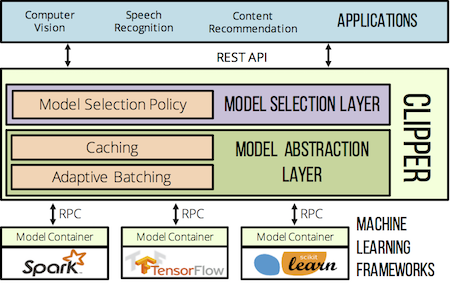Clipper Prediction Server
About the Project
Machine learning is being deployed in a growing number of applications which demand real-time, accurate, and robust predictions under heavy query load. However, most machine learning frameworks and systems only address model training and not deployment.
Clipper is the first general-purpose low-latency prediction serving system. Interposing between end-user applications and a wide range of machine learning frameworks, Clipper introduces a modular architecture to simplify model deployment across frameworks. Furthermore, by introducing caching, batching, and adaptive model selection techniques, Clipper reduces prediction latency and improves prediction throughput, accuracy, and robustness without modifying the underlying machine learning frameworks.
Additional Resources
Clipper is a project in the UC Berkeley RISE Lab.
Developing
Clipper is distributed through GitHub.
Clone the repository and submodules:
$ git clone --recursive https://github.com/ucbrise/clipper.git
Dependencies
- Boost >= 1.60
- cmake >= 3.2
- zeromq >= 4.1.6
- hiredis
- libev
- redis-server >= 3.2
On a Mac you can install these with
brew install cmake boost --c++11 zeromq hiredis libev redis
On Debian stretch/sid:
sudo apt-get install cmake libzmq5 libzmq5-dev libhiredis-dev libev-dev libboost-all-dev
On other Linux distributions, depending on which distro and version you are running, the supplied packages for some of these dependencies may be too old. You can try installing from your distro's package repository, and if the version of a dependency is too old you may have to build it from source.
Building
First generate the cmake files with ./configure. This generates an out-of-source build directory called debug.
Go into one of this directory and then run make to actually
compile the code. You should only need to re-configure if you change one of the CMakeLists.txt files.
To build for release, run ./configure --release which generates the release build directory instead of debug.
If you want to clean everything up, you can run ./configure --cleanup.
NOTE: Redis must be installed and on your path to run both the Query REST frontend and the unit-tests.
For example:
$ cd $CLIPPER_ROOT_DIR
$ ./configure
$ cd debug
$ make
# write some code and compile it
$ make
# build and run unit tests with googletest
$ ../bin/run_unittests.sh
# build and then start the query REST frontend
$ ../bin/start_clipper.shClipper has been tested on OSX 10.11, 10.12, and on Debian stretch/sid and Ubuntu 12.04 and 16.04. It does not support Windows.
Next steps
Querying Clipper
For an example of querying Clipper, see the Python example client.
Running Clipper in Docker
Clipper can also be run in Docker containers. See the Docker guide for details.
Contributing
To file a bug or request a feature, please file an issue. Pull requests are welcome.
Our mailing list is clipper-dev@googlegroups.com. For more information about the project, please contact Dan Crankshaw.
Development planning and progress is tracked with the Clipper Jira.


